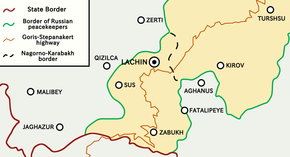This article has multiple issues. Please help improve it or discuss these issues on the talk page. (Learn how and when to remove these messages)
|


The Lachin corridor[a] was a mountain road in Azerbaijan that linked Armenia and Karabakh.[1]
Being the only road between these two territories, it was considered a humanitarian corridor or "lifeline" to the Armenian population of Nagorno-Karabakh.[2][3][4][5] The corridor is in the Lachin District of Azerbaijan, but was ostensibly under the control of a Russian peacekeeping force as provided for in the 2020 Nagorno-Karabakh armistice agreement. The territory of the corridor included the villages of Zabukh, Sus and the city of Lachin itself until 2022. On 26 August 2022, these settlements were transferred to Azerbaijani control. Four days later, a new route to the south was opened for use that bypasses the settlements of Zabukh, Sus and Lachin and instead passes by the villages of Mets Shen/Boyuk Galadarasi and Hin Shen/Kichik Galadarasi.[6]
Azerbaijan conducted a blockade of the Lachin corridor from December 2022 to September 2023, which was criticized by numerous countries, international organizations, and human rights groups,[7][8][9][10][11][12] many of which considered it a violation of the ceasefire agreement that ended the Second Nagorno-Karabakh War. On April 23, 2023, Azerbaijani officials set up a checkpoint in the corridor, claiming it was meant to prevent "illegal" transport of military supplies and natural resources,[13][14] however, the republics of Armenia and Artsakh have denied these allegations and the ceasefire agreement does not explicitly limit the use of the Lachin corridor to humanitarian needs.[15] After a renewed offensive in September 2023, Azerbaijani forces took control of the entirety of Nagorno-Karabakh,[16] which was followed by the exodus of almost all of the Armenian inhabitants of Nagorno-Karabakh into Armenia through the Lachin corridor.[17]
Cite error: There are <ref group=lower-alpha> tags or {{efn}} templates on this page, but the references will not show without a {{reflist|group=lower-alpha}} template or {{notelist}} template (see the help page).
- ^ "Azerbaijan enters Nagorno-Karabakh district after peace deal". aljazeera.com. Al Jazeera. 20 November 2020. Archived from the original on 23 December 2020.
The Russian peacekeeping force of some 2,000 troops has deployed to the administrative centre of the region, Stepanakert, and set up checkpoints and observation posts along the strategic Lachin corridor connecting Nagorno-Karabakh with Armenia.
- ^ "Lachin is a ghost-town -- a crowd of burned-out,..." UPI. Archived from the original on 17 December 2022. Retrieved 17 December 2022.
- ^ Potier, Tim (2001). Conflict in Nagorno-Karabakh, Abkhazia and South Ossetia: a legal appraisal. The Hague: Kluwer law international. p. 194. ISBN 978-90-411-1477-8.
- ^ German, Tracey (September 2015). "Negotiating Armenian-Azerbaijani peace: opportunities, obstacles, prospects. By Ohannes Geukjian". International Affairs. 91 (5): 92. doi:10.1111/1468-2346.12424. ISSN 0020-5850. Archived from the original on 19 September 2023. Retrieved 10 August 2023.
- ^ "France calls on Azerbaijan to reopen humanitarian corridor with Armenia". France 24. 28 April 2023. Archived from the original on 10 August 2023. Retrieved 10 August 2023.
- ^ Shahverdyan, Lilit; Kucera, Joshua (15 September 2022). "Armenians warily travel along "the new road" to Karabakh | Eurasianet". Eurasianet. Archived from the original on 22 September 2022. Retrieved 22 September 2022.
- ^ Kitachayev, Bashir (16 December 2022). "Azerbaijani roadblock cuts tens of thousands off from food, fuel and medicine". openDemocracy. Archived from the original on 26 February 2023. Retrieved 21 December 2022.
- ^ "Azerbaijan closes Lachin Corridor to install checkpoint". OC Media. 24 April 2023. Archived from the original on 10 May 2023. Retrieved 1 May 2023.
- ^ "PACE rapporteur seeks to visit Lachin corridor". OC Media. 25 April 2023. Archived from the original on 2 May 2023. Retrieved 1 May 2023.
- ^ Ahmedbeyli, Samira (24 April 2023). "Azerbaijan has installs checkpoint at entrance to Lachin road. Information and comments from Baku and Yerevan". English Jamnews. Archived from the original on 1 May 2023. Retrieved 1 May 2023.
- ^ "PRESS RELEASE : Checkpoint on the Lachin Corridor – UK statement to the OSCE [April 2023] – UKPOL.CO.UK". 27 April 2023. Archived from the original on 3 May 2023. Retrieved 1 May 2023.
- ^ Canada, Global Affairs (25 April 2023). "Canada concerned with latest developments in Lachin Corridor". www.canada.ca. Archived from the original on 1 May 2023. Retrieved 1 May 2023.
- ^ Presse, AFP-Agence France. "Azerbaijan Says Set Up Checkpoint On Key Route To Armenia". www.barrons.com. Archived from the original on 23 April 2023. Retrieved 23 April 2023.
- ^ "Azerbaijan installs checkpoint on road to Nagorno-Karabakh amid fatal clashes". POLITICO. 23 April 2023. Archived from the original on 2 May 2023. Retrieved 3 May 2023.
- ^ Council of Europe: Parliamentary Assembly. "Committee on the Honouring of Obligations and Commitments by Member States of the Council of Europe (Monitoring Committee):The honouring of obligations and commitments by Armenia: Information note following the visit in Armenia from 17 to 19 February 2023". Archived from the original on 21 April 2023. Retrieved 24 April 2023.
The Trilateral Statement contains no provision limiting explicitly the use of this road to humanitarian needs.
- ^ Roth, Andrew (24 September 2023). "First evacuees from Nagorno-Karabakh cross into Armenia". The Guardian. Archived from the original on 24 September 2023. Retrieved 24 September 2023.
- ^ Sauer, Pjotr (2 October 2023). "'It's a ghost town': UN arrives in Nagorno-Karabakh to find ethnic Armenians have fled". The Guardian. ISSN 0261-3077. Retrieved 4 March 2024.